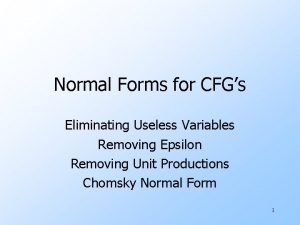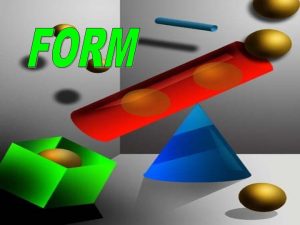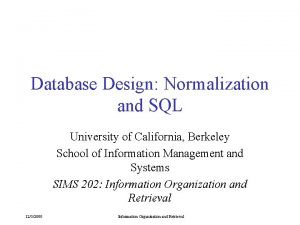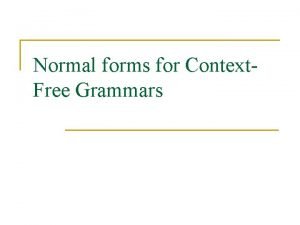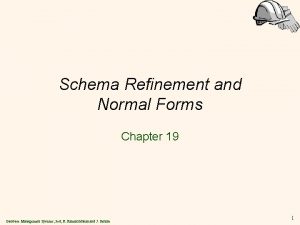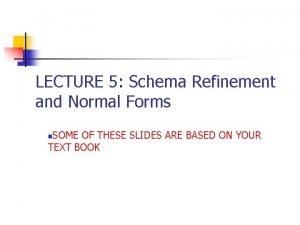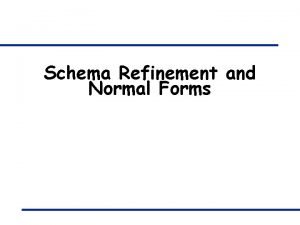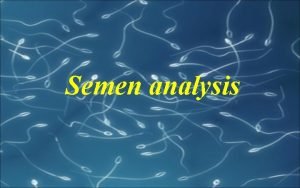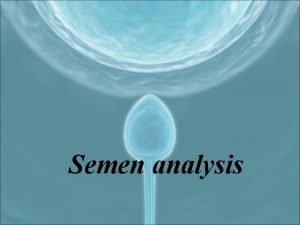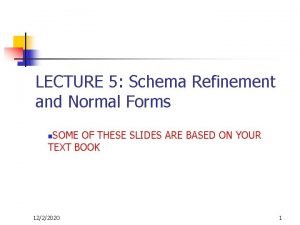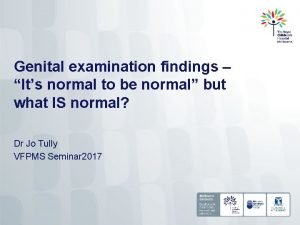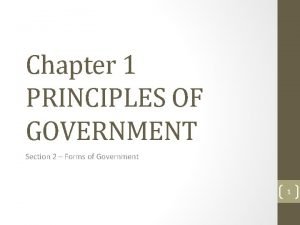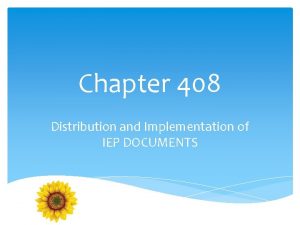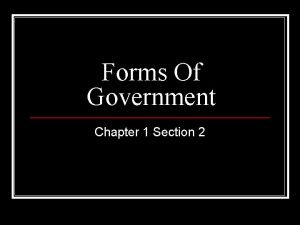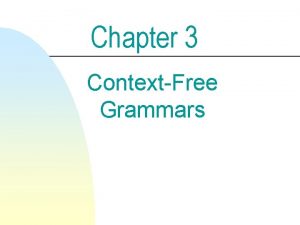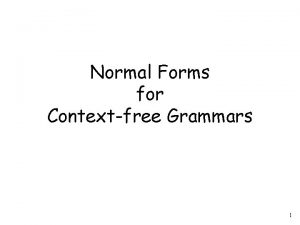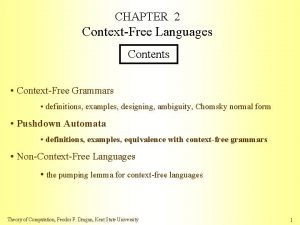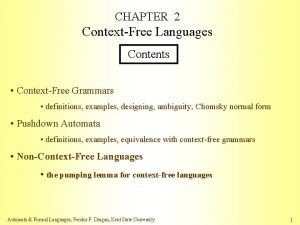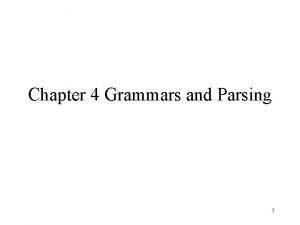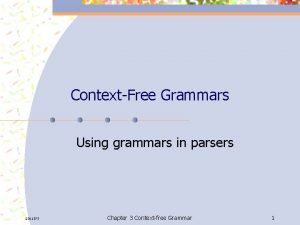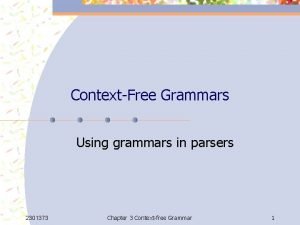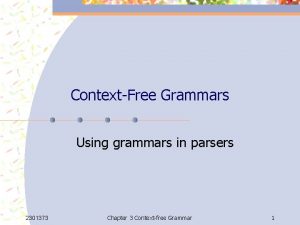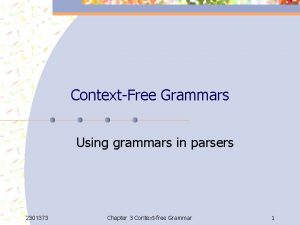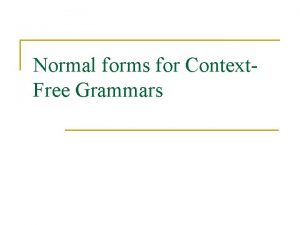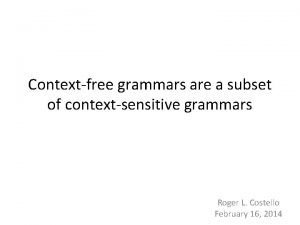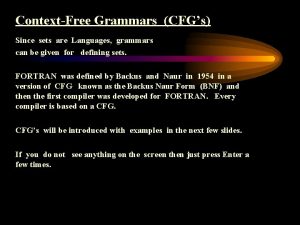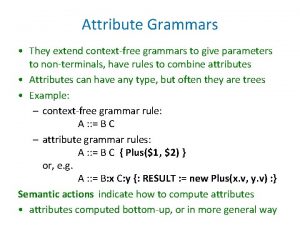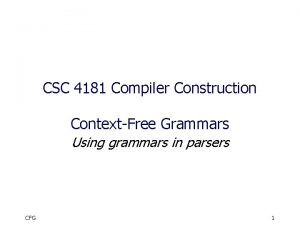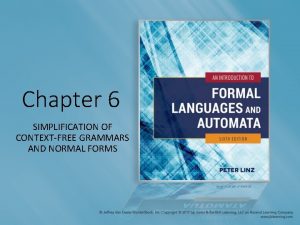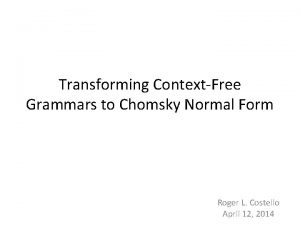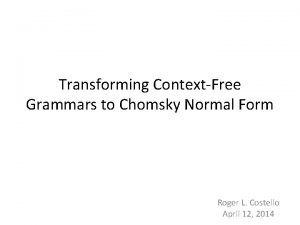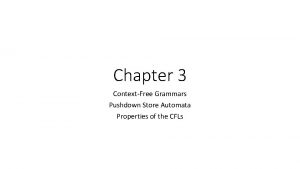ContextFree Grammars Normal Forms Chapter 11 Normal Forms


























- Slides: 26

Context-Free Grammars Normal Forms Chapter 11

Normal Forms A normal form F for a set C of data objects is a form, i. e. , a set of syntactically valid objects, with the following two properties: ● For every element c of C, except possibly a finite set of special cases, there exists some element f of F such that f is equivalent to c with respect to some set of tasks. ● F is simpler than the original form in which the elements of C are written. By “simpler” we mean that at least some tasks are easier to perform on elements of F than they would be on elements of C.

Normal Forms If you want to design algorithms, it is often useful to have a limited number of input forms that you have to deal with. Normal forms are designed to do just that. Various ones have been developed for various purposes. Examples: ● Clause form for logical expressions to be used in resolution theorem proving ● Disjunctive normal form for database queries so that they can be entered in a query by example grid. ● Various normal forms for grammars to support specific parsing techniques.

Normal Forms for Grammars Chomsky Normal Form, in which all rules are of one of the following two forms: ● X a, where a , or ● X BC, where B and C are elements of V - . Advantages: ● Parsers can use binary trees. ● Exact length of derivations is known: S A B A A B B a a b B b

Normal Forms for Grammars Greibach Normal Form, in which all rules are of the following form: ● X a , where a and (V - )*. Advantages: ● Every derivation of a string s contains |s| rule applications. ● Greibach normal form grammars can easily be converted to pushdown automata with no transitions. This is useful because such PDAs are guaranteed to halt.

Normal Forms Exist Theorem: Given a CFG G, there exists an equivalent Chomsky normal form grammar GC such that: L(GC) = L(G) – { }. Proof: The proof is by construction. Theorem: Given a CFG G, there exists an equivalent Greibach normal form grammar GG such that: L(GG) = L(G) – { }. Proof: The proof is also by construction.

Converting to a Normal Form 1. Apply some transformation to G to get rid of undesirable property 1. Show that the language generated by G is unchanged. 2. Apply another transformation to G to get rid of undesirable property 2. Show that the language generated by G is unchanged and that undesirable property 1 has not been reintroduced. 3. Continue until the grammar is in the desired form.

Rule Substitution X a. Yc Y b Y ZZ We can replace the X rule with the rules: X abc X a. ZZc X a. Yc a. ZZc

Rule Substitution Theorem: Let G contain the rules: X Y and Y 1 | 2 | … | n , Replace X Y by: X 1 , X 2 , …, X n. The new grammar G will be equivalent to G.

Rule Substitution Theorem: Let G contain the rules: X Y and Y 1 | 2 | … | n Replace X Y by: X 1 , X 2 , …, X n. The new grammar G will be equivalent to G.

Rule Substitution Replace X Y by: X 1 , X 2 , …, X n. Proof: ● Every string in L(G) is also in L(G ): If X Y is not used, then use same derivation. If it is used, then one derivation is: S … X Y k … w Use this one instead: S … X k … w ● Every string in L(G ) is also in L(G): Every new rule can be simulated by old rules.

Conversion to Chomsky Normal Form 1. Remove all -rules, using the algorithm remove. Eps. 2. Remove all unit productions (rules of the form A B). 3. Remove all rules whose right hand sides have length greater than 1 and include a terminal: (e. g. , A a. B or A Ba. C) 4. Remove all rules whose right hand sides have length greater than 2: (e. g. , A BCDE)

Removing -Productions Remove all productions: (1) If there is a rule P Q and Q is nullable, Then: Add the rule P . (2) Delete all rules Q .

Removing -Productions Example: S a. A A B | CDC B B a C BD D b D

Unit Productions A unit production is a rule whose right-hand side consists of a single nonterminal symbol. Example: S X Y X A A B | a B b Y T T Y | c

Removing Unit Productions remove. Units(G) = 1. Let G = G. 2. Until no unit productions remain in G do: 2. 1 Choose some unit production X Y. 2. 2 Remove it from G. 2. 3 Consider only rules that still remain. For every rule Y , where V*, do: Add to G the rule X unless it is a rule that has already been removed once. 3. Return G. After removing epsilon productions and unit productions, all rules whose right hand sides have length 1 are in Chomsky Normal Form.

Removing Unit Productions remove. Units(G) = 1. Let G = G. 2. Until no unit productions remain in G do: 2. 1 Choose some unit production X Y. 2. 2 Remove it from G. 2. 3 Consider only rules that still remain. For every rule Y , where V*, do: Add to G the rule X unless it is a rule that has already been removed once. 3. Return G. Example: S X Y X A A B | a B b Y T T Y | c

Removing Unit Productions remove. Units(G) = 1. Let G = G. 2. Until no unit productions remain in G do: 2. 1 Choose some unit production X Y. 2. 2 Remove it from G. 2. 3 Consider only rules that still remain. For every rule Y , where V*, do: Add to G the rule X unless it is a rule that has already been removed once. 3. Return G. Example: S X Y X A A B | a B b Y T T Y | c S X Y A a | b B b T c X a | b Y c

Mixed Rules remove. Mixed(G) = 1. Let G = G. 2. Create a new nonterminal Ta for each terminal a in . 3. Modify each rule whose right-hand side has length greater than 1 and that contains a terminal symbol by substituting Ta for each occurrence of the terminal a. 4. Add to G, for each Ta, the rule Ta a. 5. Return G. Example: A a B A Ba. C A Bb. C

Mixed Rules remove. Mixed(G) = 1. Let G = G. 2. Create a new nonterminal Ta for each terminal a in . 3. Modify each rule whose right-hand side has length greater than 1 and that contains a terminal symbol by substituting Ta for each occurrence of the terminal a. 4. Add to G, for each Ta, the rule Ta a. 5. Return G. Example: A a B A Ba. C A Bb. C A a A Ta B A BTa C A BTb. C Ta a Tb b

Long Rules remove. Long(G) = 1. Let G = G. 2. For each rule r of the form: A N 1 N 2 N 3 N 4…Nn, n > 2 create new nonterminals M 2, M 3, … Mn-1. 3. Replace r with the rule A N 1 M 2. 4. Add the rules: M 2 N 2 M 3, M 3 N 3 M 4, … Mn-1 Nn-1 Nn. 5. Return G. Example: A BCDEF

An Example S a. ACa A B | a B C | c C c. C | remove. Eps returns: S a. ACa | a. Aa | a. Ca | aa A B | a B C | c C c. C | c

An Example S a. ACa | a. Aa | a. Ca | aa A B | a B C | c C c. C | c Next we apply remove. Units: Remove A B. Add A C | c. Remove B C. Add B c. C (B c, already there). Remove A C. Add A c. C (A c, already there). So remove. Units returns: S a. ACa | a. Aa | a. Ca | aa A a | c. C B c | c. C C c. C | c

An Example S a. ACa | a. Aa | a. Ca | aa A a | c. C B c | c. C C c. C | c Next we apply remove. Mixed, which returns: S Ta. ACTa | Ta. ATa | Ta. CTa | Ta. Ta A a | c | Tc. C B c | Tc. C C Tc. C | c Ta a Tc c

An Example S Ta. ACTa | Ta. ATa | Ta. CTa | Ta. Ta A a | c | Tc. C B c | Tc. C C Tc. C | c Ta a Tc c Finally, we apply remove. Long, which returns: S Ta. S 1 S Ta. S 3 S Ta. S 4 S Ta. Ta S 1 AS 2 S 3 ATa S 4 CTa S 2 CTa A a | c | Tc. C B c | Tc. C C Tc. C | c Ta a Tc c

The Price of Normal Forms E E + E E (E) E id Converting to Chomsky normal form: E E E E P E E L E E E R E id L ( R ) P + Conversion doesn’t change weak generative capacity but it may change strong generative capacity.
 Unrestricted grammar
Unrestricted grammar Handling questions in context-free grammars
Handling questions in context-free grammars Which grammar generates regular language?
Which grammar generates regular language? How to remove epsilon productions from grammar
How to remove epsilon productions from grammar Unrestricted grammar is also known as
Unrestricted grammar is also known as Why are related forms more agreeable than unrelated forms
Why are related forms more agreeable than unrelated forms Am not contracted form
Am not contracted form Why are related forms more agreeable than unrelated forms
Why are related forms more agreeable than unrelated forms Why are related forms more agreeable than unrelated forms?
Why are related forms more agreeable than unrelated forms? Weak and strong form of can
Weak and strong form of can Normal forms in mathematical logic
Normal forms in mathematical logic Normalization in sql
Normalization in sql What are useful and useless symbols in grammar
What are useful and useless symbols in grammar Schema refinement and normal forms
Schema refinement and normal forms Schema refinement and normal forms
Schema refinement and normal forms Schema refinement
Schema refinement Normalization
Normalization Average motility of sperm
Average motility of sperm Normal sperm analysis
Normal sperm analysis Schema refinement and normal forms
Schema refinement and normal forms Hymen
Hymen 5 forms of business ownership
5 forms of business ownership Chapter 18.2 writing a cover letter
Chapter 18.2 writing a cover letter Chapter 17:4 participating in a job interview
Chapter 17:4 participating in a job interview Chapter 1 section 2 forms of government
Chapter 1 section 2 forms of government Nyc doe chapter 408 forms
Nyc doe chapter 408 forms Chapter 1 section 2 forms of government
Chapter 1 section 2 forms of government



